
Amico Aspertini, also called Amerigo Aspertini, was an Italian Renaissance painter and sculptor whose complex, eccentric, and eclectic style anticipates Mannerism. He is considered one of the leading exponents of the Bolognese School of painting.

Amico Aspertini, also called Amerigo Aspertini, was an Italian Renaissance painter and sculptor whose complex, eccentric, and eclectic style anticipates Mannerism. He is considered one of the leading exponents of the Bolognese School of painting.
He was born in Bologna to a family of painters (including Giovanni Antonio Aspertini, his father, and Guido Aspertini, his brother), and studied under masters such as Lorenzo Costa and Francesco Francia. He traveled to Rome with his father in 1496, and is briefly documented there again between 1500 and 1503, returning to Bologna thereafter and painting in a style influenced by Pinturicchio and Filippino Lippi (whose work the critic Roberto Longhi suggested [in Officina ferrarese, 1934] he may have seen in Florence before 1500). To his Roman years belong at least two collections of drawings, the "Parma Notebook" (Taccuino di Parma) and the Wolfegg Codex. In Bologna in 1504, he joined Francia and Costa in painting frescoes for the Oratory of Santa Cecilia next to San Giacomo Maggiore, a work commissioned by Giovanni II Bentivoglio.
In 1508–1509, while in exile from Bologna following the fall of the Bentivoglio family, Aspertini painted the splendid frescoes in the Chapel of the Cross in the Basilica di San Frediano in Lucca (a church, like the Oratory of Santa Cecilia, maintained by Augustinian friars). Aspertini was also one of two artists chosen to decorate a triumphal arch for the entry into Bologna of Pope Clement VII and Emperor Charles V in 1529. He produced sculptures for doors in San Petronio Basilica in Bologna. [1] [2] Aspertini also painted façade decorations (all now lost), and altarpieces. Many of his works are often eccentric and charged in expression. For example, the Pietà he painted inside San Petronio appears to occur in an other-worldly electric sky.
His Tuscan near-contemporary Giorgio Vasari described Aspertini (in The Lives ) as having an eccentric, half-insane personality. According to Vasari, he was ambidextrous and worked so rapidly with both hands that he was able to divide chiaroscuro between them, painting chiaro with one hand and scuro with the other. Vasari also quotes Aspertini as complaining that all his Bolognese colleagues were copying Raphael.
He died in Bologna.

Jacopo della Quercia, also known as Jacopo di Pietro d'Agnolo di Guarnieri, was an Italian sculptor of the Renaissance, a contemporary of Brunelleschi, Ghiberti and Donatello. He is considered a precursor of Michelangelo.

Luca Signorelli was an Italian Renaissance painter from Cortona, in Tuscany, who was noted in particular for his ability as a draftsman and his use of foreshortening. His massive frescos of the Last Judgment (1499–1503) in Orvieto Cathedral are considered his masterpiece.

Il Sodoma was the name given to the Italian Renaissance painter Giovanni Antonio Bazzi. Il Sodoma painted in a manner that superimposed the High Renaissance style of early 16th-century Rome onto the traditions of the provincial Sienese school; he spent the bulk of his professional life in Siena, with two periods in Rome.
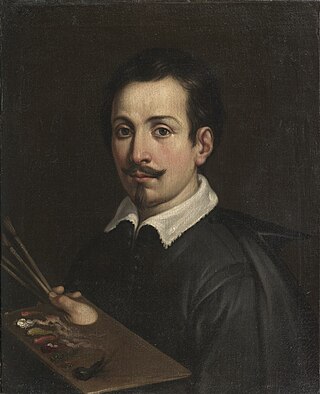
Guido Reni was an Italian painter of the Baroque period, although his works showed a classical manner, similar to Simon Vouet, Nicolas Poussin, and Philippe de Champaigne. He painted primarily religious works, but also mythological and allegorical subjects. Active in Rome, Naples, and his native Bologna, he became the dominant figure in the Bolognese School that emerged under the influence of the Carracci.

Pinturicchio, or Pintoricchio, also known as Benetto di Biagio or Sordicchio, was an Italian Renaissance painter. He acquired his nickname because of his small stature and he used it to sign some of his artworks that were created during the fifteenth and sixteenth centuries.
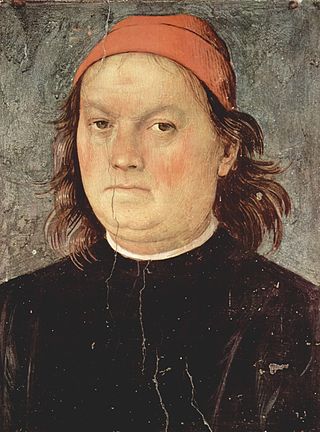
Pietro Perugino, an Italian Renaissance painter of the Umbrian school, developed some of the qualities that found classic expression in the High Renaissance. Raphael became his most famous pupil.
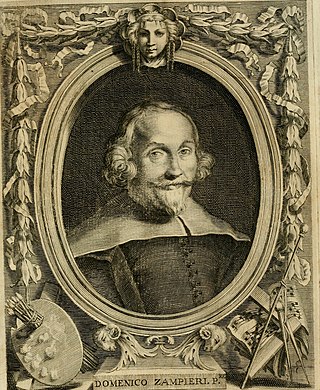
Domenico Zampieri, known by the diminutive Domenichino after his shortness, was an Italian Baroque painter of the Bolognese School of painters.

Giacomo Cavedone was an Italian Baroque painter of the Bolognese School.

Francesco Francia, whose real name was Francesco Raibolini was an Italian painter, goldsmith, and medallist from Bologna, who was also director of the city mint.
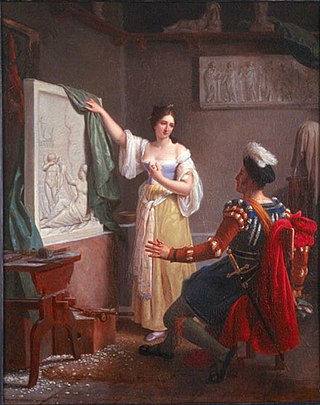
Properzia de' Rossi was a ground-breaking female Italian Renaissance sculptor and one of only four women to receive a biography in Vasari's Lives of the Artists.

Giovanni Lanfranco was an Italian painter of the Baroque period.

The Basilica of San Petronio is a minor basilica and church of the Archdiocese of Bologna located in Bologna, Emilia Romagna, northern Italy. It dominates Piazza Maggiore. The basilica is dedicated to the patron saint of the city, Saint Petronius, who was the bishop of Bologna in the fifth century. Construction began in 1390 and its main facade has remained unfinished since. The building was transferred from the city to the diocese in 1929; the basilica was finally consecrated in 1954. It has been the seat of the relics of Bologna's patron saint only since 2000; until then they were preserved in the Santo Stefano church of Bologna.

Alessandro Tiarini was an Italian Baroque painter of the Bolognese School.
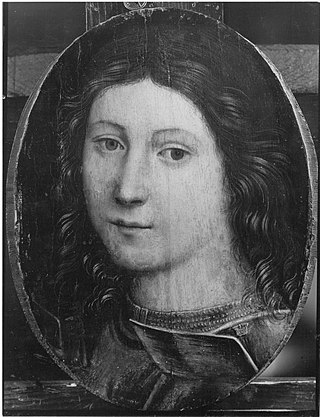
Ercole Grandi was an Italian painter of the early-Renaissance period, active mainly in Ferrara. Also known as Ercole da Ferrara and Ercole di Giulio Cesare Grandi, he has been claimed to be a favourite pupil of the painter Lorenzo Costa. Ercole Grandi first appeared in the historical record as being in the service of the house of Este in 1489. Between 1489 and 1495, Ercole Grandi seems to have been working in Bologna, both in San Petronio and in the Cappella Bentivoglio of San Giacomo Maggiore, as an assistant to Lorenzo Costa. In 1495, he was in Ferrara as the chief architect for realising Duke Ercole's plans to embellish the city and renovate the churches; the facade and interior of Santa Maria in Vado were executed from his design. He worked with Ludovico Mazzolino and others on the decoration of the Castello, and painted in the apartments of Lucretia Borgia. Also in Ferrara, he painted the frescoes for the church of San Pietro Martire, although some frescoes are preserved. One problem in assigning attribution to the hand of Ercole Grandi is that none of his works is signed or dated, or accompanied by supporting documents, but he is thought by some scholars to have painted—in the manner of Mantegna—or had a hand in, the decorative frescoed ceiling in the Sala del Tesoro of the Palazzo Costabili in Ferrara between 1503 and 1506. Other scholars attribute the work to Benvenuto Tisi da Garofalo. Confusingly, the identity of Ercole Grandi is sometimes conflated with Garofalo, and an Ercole da Bologna, and with that of Ercole di Antonio Roberti or Ercole de' Roberti, who was first documented as being in Ferrara in 1479, and was author of the great frescoes of the Garganelli chapel in Bologna. Most of Ercole Grandi's works have been reattributed to other Ferrarese painters, such as Giovan Francesco Maineri and Lorenzo Costa, while other scholars insist that Ercole Grandi is a mythical character.

Ercole de' Roberti, also known as Ercole Ferrarese or Ercole da Ferrara, was an Italian artist of the Early Renaissance and the School of Ferrara. He was profiled in Vasari's Le Vite delle più eccellenti pittori, scultori, ed architettori. The son of the doorkeeper at the Este castle, Ercole later held the position of court artist for the Este family in Ferrara. According to Vasari:
Ercole had an extraordinary love of wine, and his frequent drunkenness did much to shorten his life, which he had enjoyed without any accident up to the age of forty, when he was smitten one day by apoplexy, which made an end of him in a short time.

Michele Ridolfi was an Italian painter and art critic.
Giovanni Maria Chiodarolo was an Italian painter from Bologna who lived in the 15th century. Little further is known of him than that the fresco of Angel crowning St. Valerian and St. Cecilia, executed about 1504–1509, in the oratory of St. Cecilia, attached to San Giacomo Maggiore, in Bologna, is by tradition assigned to him. He painted there alongside Cesare Tamarozzo. Other frescoes in the oratory were done by Francia, Amico Aspertini, and Lorenzo Costa the Elder. A Nativity in the Bologna Gallery is also ascribed to Chiodarolo.
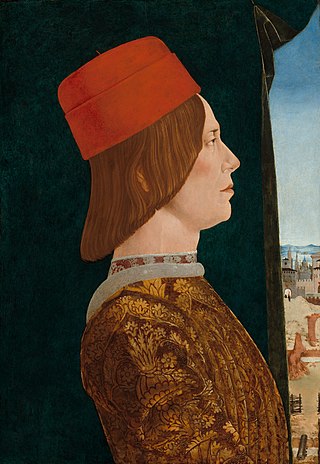
Giovanni II Bentivoglio was an Italian nobleman who ruled as tyrant of Bologna from 1463 until 1506. He had no formal position, but held power as the city's "first citizen." The Bentivoglio family ruled over Bologna from 1443, and repeatedly attempted to consolidate their hold of the Signoria of the city.

The Basilica of San Giacomo Maggiore is an historic Roman Catholic church in Bologna, region of Emilia Romagna, Italy, serving a monastery of Augustinian friars. It was built starting in 1267 and houses, among the rest, the Bentivoglio Chapel, featuring numerous Renaissance artworks.

The Oratory of Saints Cecilia and Valeriano is a religious site in central Bologna, found on Via Zamboni, contiguous to the portico of the church of San Giacomo Maggiore.
{{cite book}}: |author= has generic name (help)